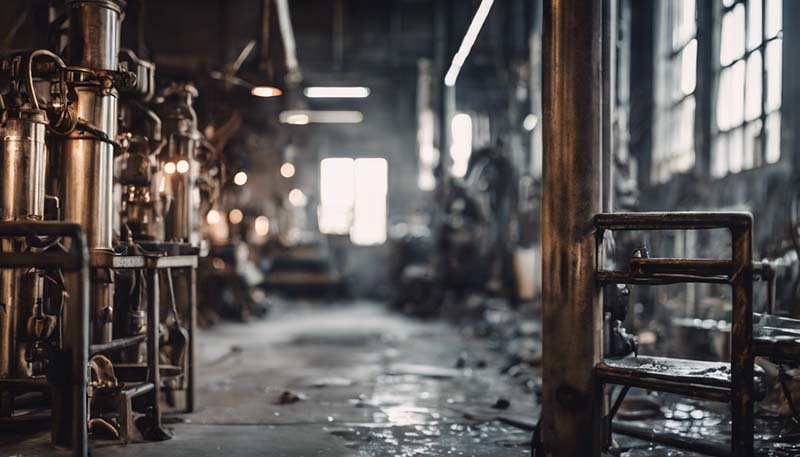Industrial Chic: The Raw Beauty of Exposed Elements
Industrial Chic: The Raw Beauty of Exposed Elements
The allure of industrial design has been capturing the imagination of architects, designers, and homeowners for decades. Its appeal lies in the honest expression of raw materials, the celebration of functional elements, and the unpretentious aesthetic that embraces the process of creation. This article delves into the essence of industrial chic and how it can be incorporated into modern living spaces to create a unique and visually striking environment.
The Origins of Industrial Design
Industrial design, as we know it today, has its roots in the late 19th and early 20th centuries, a time when the Industrial Revolution was transforming the urban landscape. Factories and warehouses were constructed with little regard for aesthetics, focusing instead on functionality and efficiency. It was only much later that designers began to appreciate the beauty in these utilitarian structures, giving rise to the industrial chic design movement.
Advertisement
The Key Elements of Industrial Chic
1. Exposed Structural Elements
A defining characteristic of industrial chic is the exposure of structural elements that are typically hidden in traditional interior design. This includes exposed brick walls, wooden ceiling beams, and metal ductwork. These elements add texture and depth to a space, creating a backdrop that is both rugged and refined.
2. Use of Raw Materials
The use of raw materials such as brick, concrete, wood, and metal is central to the industrial aesthetic. These materials are often left in their natural state, with minimal finishing, to highlight their inherent beauty and showcase the craftsmanship involved in their creation.
3. Open Floor Plans
Open floor plans are a common feature in industrial chic design, allowing for a seamless flow between different living areas. This design choice encourages social interaction and creates a sense of spaciousness that is both welcoming and practical.
4. Repurposed Furniture and Accessories
The recycling and repurposing of old furniture and industrial artifacts is a key aspect of industrial chic. Vintage factory lights, reclaimed wood tables, and metal storage units not only add character to a space but also tell a story of the past and contribute to a sustainable lifestyle.
5. Minimalist Color Palette
A minimalist color palette is often employed in industrial chic design, with a focus on neutral tones such as black, white, and gray. Accent colors are used sparingly to create visual interest and highlight specific design elements.
Creating an Industrial Chic Space
1. Start with a Strong Foundation
Begin by assessing the existing architectural features of your space. If you're fortunate enough to have exposed brick walls or wooden beams, these can serve as the foundation for your industrial chic design. If not, consider incorporating faux brick panels or exposed wood accents to achieve a similar effect.
2. Choose the Right Furniture
When selecting furniture for your industrial chic space, opt for pieces that are both functional and stylish. Metal and wood are popular choices for furniture frames, while leather and fabric upholstery can add a touch of warmth and comfort. Look for items that have an industrial feel, such as metal-framed beds, vintage-inspired desks, and reclaimed wood tables.
3. Incorporate Lighting with Character
Lighting plays a crucial role in setting the mood of an industrial chic space. Pendant lights made from metal cages or vintage factory lights can add a dramatic touch, while wall sconces and floor lamps with exposed bulbs can create a warm and inviting atmosphere. Consider using a mix of lighting styles to create visual interest and balance.

4. Accessorize with Art and Textiles
To soften the industrial aesthetic and add a touch of personality to your space, incorporate art and textiles that reflect your interests and style. Choose artwork that features bold, graphic elements or abstract patterns that complement the industrial vibe. Textiles, such as throw pillows, blankets, and rugs, can add color and texture, while also providing a cozy counterpoint to the harder materials found in industrial design.
5. Embrace the Imperfections
One of the most appealing aspects of industrial chic is its embrace of imperfection. Don't be afraid to showcase the natural wear and patina of materials, or to allow for some visual roughness in your design. This authenticity is what gives industrial chic its unique charm and character.
Conclusion
Industrial chic is more than just a design trend; it's a celebration of history, craftsmanship, and the beauty of raw, unadorned materials. By incorporating the key elements of exposed structural features, raw materials, open floor plans, repurposed furniture, and a minimalist color palette, you can create a space that is as functional as it is visually stunning. Remember, the essence of industrial chic lies in its honesty and authenticity, so embrace the imperfections and let the character of the space shine through.
Further Reading:
- "The Industrial Revolution and the Birth of Modern Design"
- "Sustainable Living: Incorporating Repurposed Elements into Your Home"
- "Lighting Design in Industrial Spaces: Tips and Techniques"
 2024-02-27
2024-02-27 167 Comments
167 Comments